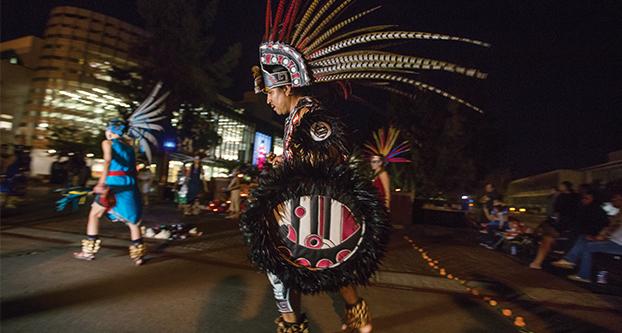Fresno State’s Aztec Dance Club celebrated the DÃa de los Muertos Celebration from Oct. 31 to Nov. 2 in the Free Speech Area with Altar displays.
Students and community members were invited to create altar displays commemorating their deceased loved ones.
Altars were made by former and current students, as well as by teachers at Fresno State.
“An altar is more like a dedication, a place where you put all of the ceremonial items for your family,” said Hector Cerda member of the Aztec Dance Club and dance group Yoztalteptl. “It’s a place where if you need to sit in front of and pray and think about your ancestors for a little bit… if you just want to remember your loved ones that’s the place you go.”
Gloria Guerrero, creator of the Aztec Dance group Yoztaltepetl said that Oct. 31 is celebrated to remember those who have died of non-natural causes such as in accidents or war.
“Nobody remembers them, that’s why we start on the 31st,” she said.
On Nov. 1, children who have passed away are remembered. “For small children we put milk, water and toys and then they leave,” Guerrero added.
Once they leave, adults are remembered on Nov. 2.
“Adults leave at night when we say goodbye with songs and as we are putting away the altars,” Guerrero added.
Cerda said that traditionally, Mexicans have altars in their homes all the time, and on the day of the death celebration they go to the cemetery to take diseased ones food, flowers and things they loved.
“What we did here is we kind of brought the altar to the university,” Cerda said.
Cerda said that by having altars at Fresno State, students’ who put them together are able to learn about the celebration.
“I think it really brings the opportunity for students to share their culture here,” Cerda said.
Viewing for the altars started Sunday morning after a spiritual run. The run took place from the cemetery to Fresno State.
Guerrero explained the meaning behind the altars. She said there are many with different amount of levels.
“We have the altar that has four levels. Each level has a meaning, north, south, east and west, and the four seasons for the year. We start at the top with the smallest level and then they get bigger and bigger,” Guerrero said.
The first level has four wands in each corner forming a square. Those wands represent the stages of a human being which are: birth, childhood, youth and old age. This level is white and also represents winter.
The second level represents spring. Guerrero said that the food they loved such as tamales is placed on this level.
The third level is the most significant of the altar; it represents summer and the color is red. It represents all those who fought for peace.
“The fourth level represents autumn and it’s where we place all the aromatic things they liked,” Guerrero said.




